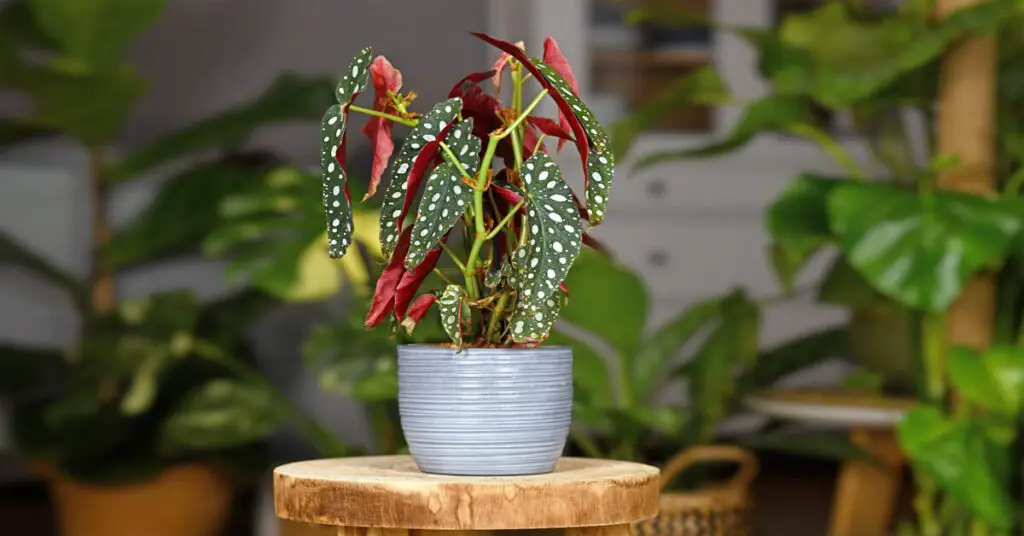Begonia maculata is a relatively difficult-to-find plant. It’s also referred to by its scientific name, Hypoestes phyllostachya, and is better known as the Polka Dot Begonia. This Acanthaceae-family plant is native to Madagascar but is mainly grown as a houseplant.
Polka Dot Begonias feature green, wing-like leaves with red-orange undersides. They’re primarily famed for the polka dot pattern on the tops of their leaves, hence their common name. With proper care, this warm-loving perennial will create several clusters of small red, pink, or white flowers.
Polka Dot Begonia Care
Compared to other cane begonias like itself, the Polka Dot Begonia is easier to take care of. Expect low maintenance and high tolerance overall.
While it isn’t difficult to keep alive, there are some things you’ll want to know regarding the care for your Begonia maculata. Read on to learn more about the needs of your Polka Dot Plant, including its preferred lighting, when to water it, and more.
Soil
Consider planting or transplanting your Begonia maculata into a standard houseplant potting mix.
Because these plants enjoy moisture to an extent, make sure the soil you choose helps retain some water. However, since they also need properly aerated soil, it wouldn’t hurt to add extra perlite to your plant’s soil.
Watering
Keep the soil of your Polka Dot Begonia mildly moist. Yet, do not water your plant again until the top half-inch of soil is dry.
When watering, avoid making the soil soggy or muddy. Water less during the wintertime when temperatures indoors are cooler, and sunlight is more scarce. Excessive watering of this houseplant can lead to a variety of different diseases and, ultimately, the plant’s death.
Lighting
Like many houseplants, the Begonia maculata enjoys bright, indirect light.
Avoid direct light at all costs as this lighting is too harsh and can scorch its leaves or lead to pale-colored foliage.
If you notice your Polka Dot Begonia is not showcasing flowers, despite having reached maturity, consider giving it more light to encourage blooming.
Humidity & Temperature
For best results, ensure your Begonia maculata is within the temperature range of 65 to 85 degrees Fahrenheit. This plant loves high humidity, preferably above 45%.
Fertilizing
During periods of active growth, your begonia will enjoy some extra nutrients via water-soluble fertilizer.
Fertilize your begonia once every two to four weeks or so during its active growth period. Its active growth period typically falls around the warmer seasons. Refrain from fertilizing during times of dormancy (fall and winter).
Propagation
Begonia maculata are fairly easy to propagate. Propagation of this houseplant is easiest via stem cuttings rooted in soil or water.
Diseases & Pests
Some common begonia diseases include powdery mildew, bacterial leaf spot, and pythium rot. These typically occur due to overwatering and restricted aeration of soil, which is the Polka Dot Begonia’s worst enemy.
Pests that the Polka Dot Begonia might be susceptible to include spider mites, thrips, blackflies, aphids, scale, and mealybugs. If your plant is looking unhappy, make sure to check the undersides of its leaves to look for these common pests.
Toxicity
While the Polka Dot Plant is deemed non-toxic, small children and pets may experience mild irritation and/or vomiting when coming in contact with the plant. However, compared to other houseplants, its toxic tendencies are quite mild.
Polka Dot Begonia vs Wightii
Not all Polka Dot Begonias are Wightii Begonias, but all Wightii Begonias are Polka Dot Begonias.
The Begonia maculata ‘Wightii’ is a specific Polka Dot variety. It features the maculata’s beloved winged leaf shape with rusty undertones.
However, Wightii always features white polka dots. As it reaches maturity, Wightii will bloom white flowers. Meanwhile, other Polka Dot Begonias can feature flowers in different colors, including pink or red, and even different spot colors depending on the hybrid.

